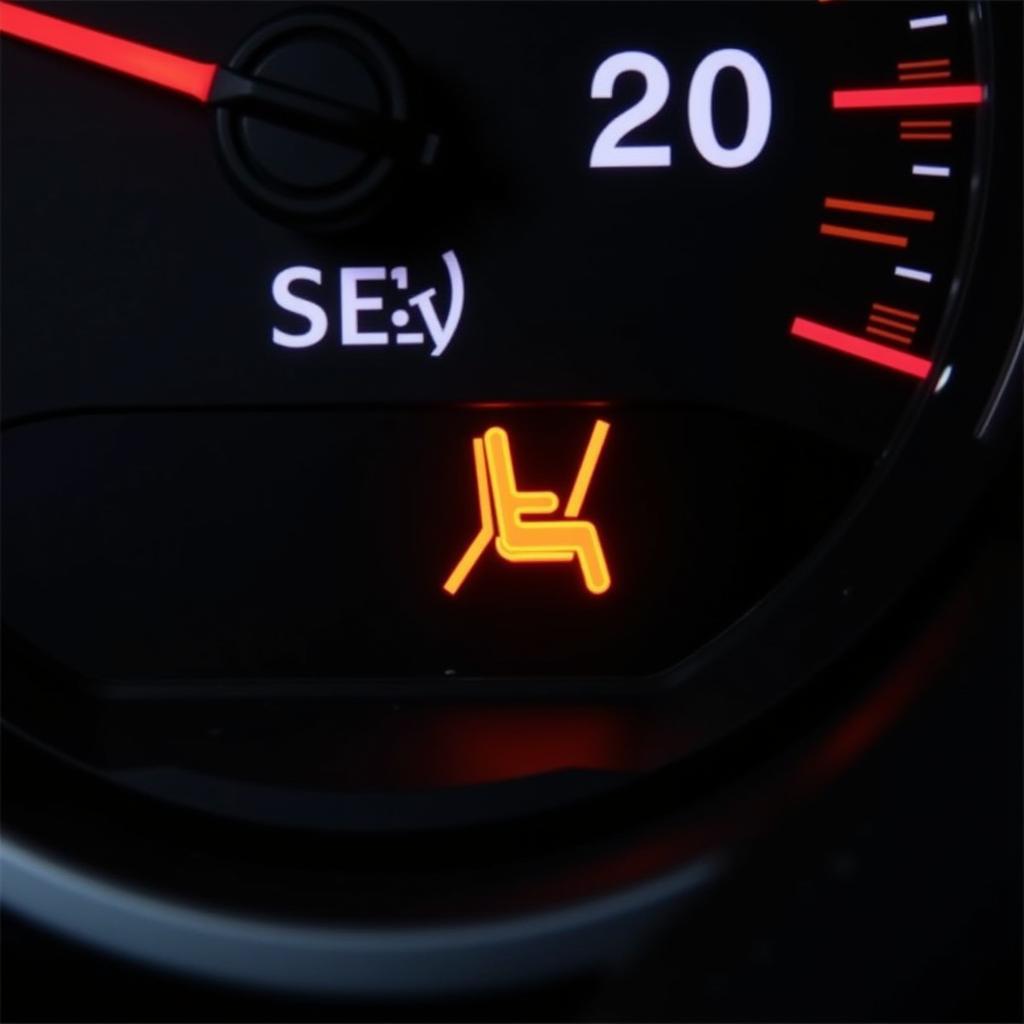The seat belt warning light is a crucial safety feature in modern vehicles, reminding drivers and passengers to buckle up. However, encountering a seat belt warning light that stays on even when everyone is securely fastened can be frustrating. This issue can stem from a variety of causes, ranging from simple glitches to underlying electrical problems. This comprehensive guide will delve into the common reasons behind a persistent seat belt warning light and provide effective solutions to help you address this issue.
 Seat Belt Warning Light Illuminated on a Car Dashboard
Seat Belt Warning Light Illuminated on a Car Dashboard
Understanding the Seat Belt Warning System
Before we dive into troubleshooting, it’s helpful to understand how the seat belt warning system works. In most vehicles, the system comprises these key components:
- Seat Belt Buckle Sensors: Located within the buckle receptacles, these sensors detect when a seat belt is fastened.
- Seat Belt Pretensioners: These devices tighten the seat belts in the event of a collision to secure occupants.
- Warning Light and Chime: The dashboard warning light and audible chime alert the driver and passengers to fasten their seat belts.
These components work together to ensure occupant safety. When a seat belt is unbuckled or improperly fastened, the buckle sensor sends a signal to the car’s computer, triggering the warning light and chime.
Why Your Seat Belt Warning Light Won’t Turn Off
Now, let’s explore the reasons why your seat belt warning light might stay on even when you’re buckled up:
1. Faulty Seat Belt Buckle Sensor
One of the most common culprits is a malfunctioning seat belt buckle sensor. Over time, these sensors can wear out, get dirty, or become damaged, leading to inaccurate readings.
Solution: If you suspect a faulty buckle sensor, try cleaning the buckle receptacles with compressed air or a cotton swab and electrical contact cleaner. If this doesn’t resolve the issue, the sensor may need to be replaced.
2. Wiring Problems
The wiring harness connecting the seat belt sensors to the car’s computer can also be responsible for the persistent warning light. Loose connections, corrosion, or damaged wires can disrupt the signal flow.
Solution: Inspect the wiring harness for any visible signs of damage or loose connections. If you discover any issues, repair or replace the affected wiring sections.
3. Software Glitches
Modern vehicles rely heavily on software, and occasionally, glitches in the car’s computer system can cause the seat belt warning light to malfunction.
Solution: In such cases, a software update or reset may be necessary. You can try disconnecting the battery for a few minutes to reset the system, or visit a qualified mechanic or dealership for a software check and update.
how seat belt warning light works
4. Weight Sensor Issues (Passenger Seat)
Some vehicles have weight sensors in the passenger seat to detect if a passenger is present and trigger the seat belt warning accordingly. If the weight sensor malfunctions, it can lead to a false warning.
Solution: Check for any objects stored under the passenger seat that might be interfering with the weight sensor. If the sensor is faulty, it will need to be replaced.
5. Aftermarket Accessories or Modifications
Installing aftermarket accessories that interfere with the seat belt system, such as seat covers or seat heaters, can also trigger a false warning light.
Solution: Temporarily remove any recently installed aftermarket accessories or modifications to see if the issue resolves. If it does, you may need to reposition or choose different accessories.
Diagnosing the Problem
If you’re unable to pinpoint the cause of the persistent seat belt warning light, it’s essential to seek professional diagnosis:
- Diagnostic Scan: A qualified mechanic can connect a diagnostic scanner to your vehicle’s computer system to read error codes related to the seat belt system. This can help pinpoint the faulty component or area requiring attention.
- Visual Inspection: A mechanic will visually inspect the seat belt system components, including the buckles, sensors, and wiring, for any visible signs of damage or malfunction.
Addressing the Seat Belt Warning Light: DIY vs. Professional Help
While some seat belt warning light issues can be resolved with simple DIY fixes, others require professional expertise. Here’s a guide to help you decide:
DIY Solutions:
- Cleaning seat belt buckle sensors
- Checking for objects obstructing weight sensors
- Temporarily removing aftermarket accessories
Professional Assistance:
- Diagnosing complex electrical problems
- Repairing or replacing faulty sensors
- Addressing software glitches
- Fixing wiring issues
Importance of a Functioning Seat Belt Warning System
Remember, a functioning seat belt warning system is crucial for your safety and the safety of your passengers. It serves as a constant reminder to buckle up, significantly reducing the risk of injuries in case of an accident.
seat belt warning system relay
Conclusion
A seat belt warning light that won’t go off, even when all occupants are properly buckled, should never be ignored. By understanding the common causes and solutions outlined in this guide, you can take the necessary steps to address the issue promptly. Whether it’s a simple DIY fix or seeking professional assistance, ensuring a fully functional seat belt warning system is paramount for your safety on the road.
